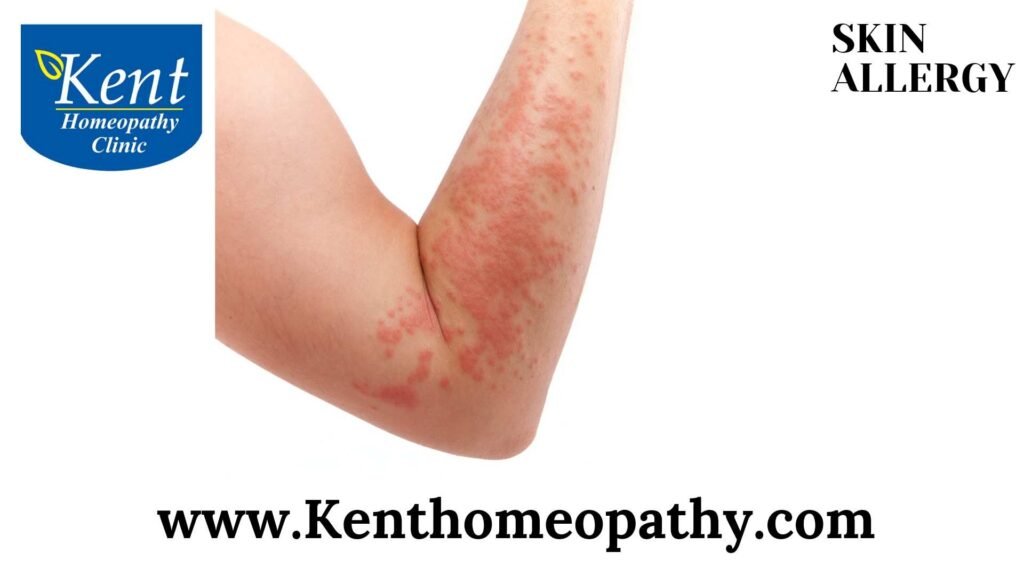Skin allergy

Skin Allergy: Unraveling Symptoms, Causes, and Types
Skin allergies, also known as allergic dermatitis, are hypersensitive reactions of the skin to certain substances, typically harmless, referred to as allergens. These allergies can manifest in various forms and range from mild itching to severe rashes and inflammation. Understanding the symptoms, causes, and types of skin allergies is essential for accurate diagnosis and effective management.
Symptoms:
- Itching (Pruritus):
– Itching is a common and often the first symptom of skin allergies. It can range from mild to severe and may lead to scratching, exacerbating the condition.
- Redness (Erythema):
– Allergic reactions can cause redness of the skin, giving it a flushed appearance. The intensity of redness varies depending on the severity of the allergy.
- Rash or Hives:
– Skin allergies often manifest as rashes or hives, which are raised, swollen welts on the skin. These can be itchy and may vary in size and shape.
- Dry or Scaly Skin:
– Dryness and scaliness of the skin are common symptoms, especially when the allergen disrupts the skin’s natural barrier function.
- Inflammation:
– Allergic dermatitis can lead to inflammation, causing swelling and tenderness in the affected areas.
- Blistering:
– In some cases, skin allergies may result in the formation of blisters filled with fluid, adding to the discomfort.
- Oozing or Crusting:
– Allergic reactions may lead to oozing of clear or yellow fluid from affected areas. As the condition progresses, crusting may occur.
- Pain or Discomfort:
– Pain or discomfort can be associated with more severe skin allergies, particularly when the skin is inflamed or blistered.
Causes:
- Contact Dermatitis:
– Contact dermatitis is one of the most common types of skin allergy. It occurs when the skin comes into direct contact with an allergen or irritant. Common triggers include certain cosmetics, fragrances, metals (nickel), and cleaning products.
- Atopic Dermatitis (Eczema):
– Atopic dermatitis, often referred to as eczema, is a chronic skin condition characterized by dry, itchy skin. Genetic and environmental factors contribute to its development, and triggers may include allergens, stress, and climate changes.
- Allergic Reaction to Medications:
– Certain medications can trigger allergic reactions leading to skin symptoms. Antibiotics, nonsteroidal anti-inflammatory drugs (NSAIDs), and anticonvulsants are examples of medications that may cause skin allergies.
- Insect Bites and Stings:
– Allergic reactions to insect bites or stings, such as those from bees, wasps, or mosquitoes, can result in localized or widespread skin allergies.
- Food Allergies:
– Some individuals may experience skin allergies as a result of food allergies. Common allergens include nuts, shellfish, dairy, and certain fruits.
- Latex Allergy:
– Latex allergy can cause skin reactions in individuals sensitive to latex products, such as gloves or medical devices.
- Plant Allergies:
– Contact with certain plants, including poison ivy, poison oak, or poison sumac, can lead to allergic contact dermatitis characterized by a red, itchy rash.
Types:
- Contact Dermatitis:
– Contact dermatitis is divided into irritant contact dermatitis and allergic contact dermatitis. Irritant contact dermatitis occurs when the skin is exposed to a substance causing irritation, while allergic contact dermatitis involves an immune response to an allergen.
- Atopic Dermatitis (Eczema):
– Atopic dermatitis is a chronic skin condition associated with a compromised skin barrier, leading to dry, itchy skin. It often develops in childhood but can persist into adulthood.
- Urticaria (Hives):
– Urticaria, commonly known as hives, is characterized by raised, red, itchy welts on the skin. It can be triggered by various allergens, including foods, medications, or insect stings.
- Angioedema:
– Angioedema involves swelling in deeper layers of the skin, often around the eyes and lips. It can occur alongside urticaria and is sometimes associated with more severe allergic reactions.
- Nummular Dermatitis:
– Nummular dermatitis is a form of dermatitis characterized by coin-shaped lesions on the skin. While the exact cause is not always clear, it can be associated with skin dryness and irritants.
- Stasis Dermatitis:
– Stasis dermatitis is typically associated with poor circulation and occurs in the lower legs. It is characterized by redness, scaling, and swelling.
- Seborrheic Dermatitis:
– Seborrheic dermatitis is a chronic condition that affects areas with a high concentration of sebaceous glands. It can cause red, scaly patches on the scalp, face, and other areas.
Contact to know more
Contact
Timings
Monday to Saturday:
11:00 AM to 02:30 PM
06:30 PM to 09:00 PM
